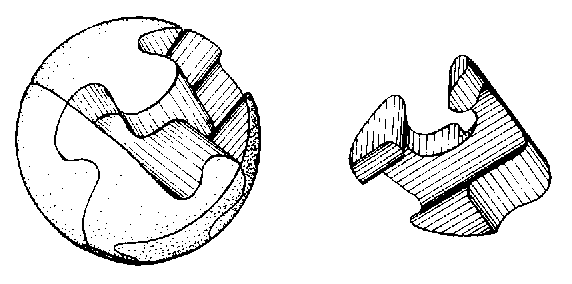
[Home] [Contents] [Figures] [Search] [Help]
[Next Page] [Prev Page] [ Next Chapter] [Prev Chapter]
To dissect means literally to cut into pieces. Just about any chunk of material cut into pieces becomes a sort of dissection puzzle. If sawn freely perpendicular to the surface of a sheet of plywood (or die-cut of cardboard), the result is the familiar jigsaw puzzle. Most jigsaw puzzles are not designed to exercise or perplex the mind, at least in the sense that other types of puzzles do, and it is perhaps stretching the definition a bit to even call them puzzles. The definition given in the dictionary for the noun puzzle seems to have been purposely broadened so as to include what are really pastimes of pattern recognition, memory, and patience. The definition given for the verb to puzzle contains no such connotation.
Jigsaw puzzles have been around for over 200 years, longer than nearly any other type of puzzle. Although their relationship to burrs and polyhedral dissections may appear to be remote, they are probably an important historical root. The ancestry of inventions in general must be an incredibly complex web of ideas branching backward in time into just about every nook and cranny of human culture. Puzzles are certainly no exception, and jigsaw puzzles, by their sheer numbers and long history, must play at least a minor role in the evolution of many present-day geometrical puzzles and recreations. How many of us played with jigsaw puzzles at one time and then began to ponder, perhaps subconsciously, variations along logical and mathematical lines?
Various schemes have been employed to make jigsaw puzzles more clever, such as by sawing on two different faces of a rectangular block or along multiple axes of a sphere. Some of these are quite entertaining, but still they are essentially non-geometrical in principle.
Fig. 5
| ©1990-2005 by Stewart T. Coffin For questions or comments regarding this site, contact the chief metagrobologist: |
[Next Page] [Prev Page] [ Next Chapter] [Prev Chapter]